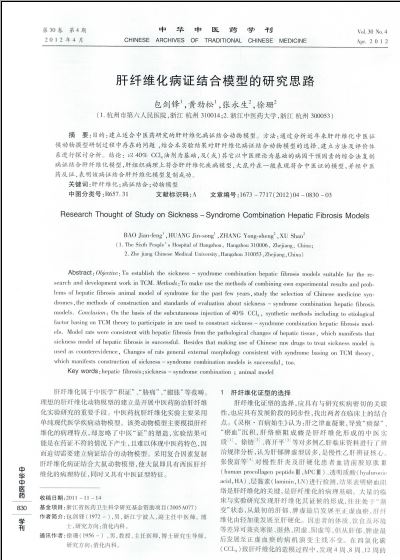肝纤维化病证结合模型的研究思路(1)
 |
| 第1页 |
参见附件。
摘 要:目的:建立适合中医药研究的肝纤维化病证结合动物模型。方法:通过分析近年来肝纤维化中医证候动物摸型研制过程中存在的问题 ,结合本实验结果对肝纤维化病证结合动物模型的选择、建立方法及评价体系进行探讨分析。结论: 以40% CCl4油剂为基础,及(或)其它以中医理论为基础的病因干预因素的综合法复制病证结合肝纤维化模型,肝组织病理上符合肝纤维化疾病模型,大鼠外在一般表现符合中医证的模型,并经中医药反证,表明该病证结合肝纤维化模型复制成功。
关键词:肝纤维化;病证结合;动物模型
中图分类号:R657.31
文献标识码:A
文章编号:1673-7717(2012)04-0830-03
Research Thought of Study on Sickness-Syndrome Combination Hepatic Fibrosis Models
BAO Jian-feng1,HUANG Jin-song1,ZHANG Yong-sheng2,XU Shan2
(1.The Sixth People’s Hospital of Hangzhou, Hangzhou 310006, Zhejiang, China;
2.Zhe jiang Chinese Medical University,Hangzhou 310053,Zhejiang,China)
Abstract:Objective:To establish the sickness-syndrome combination hepatic fibrosis models suitable for the research and development work in TCM.Methods:To make use the methods of combining own experimental results and problems of hepatic fibrosis animal model of syndrome for the past few years,study the selection of Chinese medicine syndromes,the methods of construction and standards of evaluation about sickness-syndrome combination hepatic fibrosis models. Conclusion: On the basis of the subcutaneous injection of 40% CCl4, synthetic methods including to etiological factor basing on TCM theory to participate in are used to construct sickness-syndrome combination hepatic fibrosis models. Model rats were consistent with hepatic fibrosis from the pathological changes of hepatic tissue, which manifests that sickness model of hepatic fibrosis is successful. Besides that making use of Chinese raw drugs to treat sickness model is used as counterevidence, Changes of rats general external morphology consistent with syndrome basing on TCM theory, which manifests construction of sickness-syndrome combination models is successful, too.
Key words:hepatic fibrosis;sickness-syndrome combination ; animal model
肝纤维化属于中医学“积证”、“胁痛”、“臌胀”等范畴。理想的肝纤维化动物模型的建立是开展中医药防治肝纤维化实验研究的重要手段。中医药抗肝纤维化实验主要采用单纯现代医学疾病动物模型。该类动物模型主要模拟肝纤维化的病理特点,却忽略了中医“证”的塑造,实验结果可能是在药证不符的情况下产生,且难以体现中医药特色,因而迫切需要建立病证结合的动物模型。采用复合因素复制肝纤维化病证结合大鼠动物模型,使大鼠即具有西医肝纤维化的病理特征,同时又具有中医证型特征。
1 肝纤维化证型的选择
肝纤维化证型的选择,应具有与研究疾病密切的关联性,也应具有发展阶段的同步性,找出两者在临床上的结合点。《灵枢·百病始生》认为:肝之津血凝聚,导致“痰湿”、“瘀血”沉积,肝络瘀阻成癥是肝纤维化形成的中医实质[1]。徐链[2]、蒋开平[3]等对多例乙肝临床资料进行了辨治规律分析,认为肝郁脾虚型居多,是慢性乙肝辨证核心。张俊富等[4]对慢性肝炎及肝硬化患者血清前胶原肽Ⅲ(human procollagen peptideⅢ,hPCⅢ)、透明质酸(hyaluronic acid,HA)、层黏素(laminin,LN)进行检测,结果表明瘀血阻络是肝纤维化的关键,是肝纤维化的病理基础。大量的临床与实验研究发现肝纤维化其证候的形成,往往处于“渐变”状态,从最初的肝郁、脾虚最后发展至正虚血瘀,肝纤维化由轻加重发展至肝硬化。因患者的体质、饮食及环境等差异可兼夹寒湿、湿热、阴虚、阳虚等,但从肝郁、脾虚最后发展至正虚血瘀的病机演变主线不变。在四氯化碳(CCL4)致肝纤维化的造模过程中,发现4周、8周、12周的的大鼠分别出现了易激惹、打斗(4周);胃纳锐减、便溏(8周);喜静少动、爪甲紫暗、肌表赤缕(12周)等具有时相性的中医证候演变规律 ......
您现在查看是摘要介绍页,详见PDF附件(2894kb)。